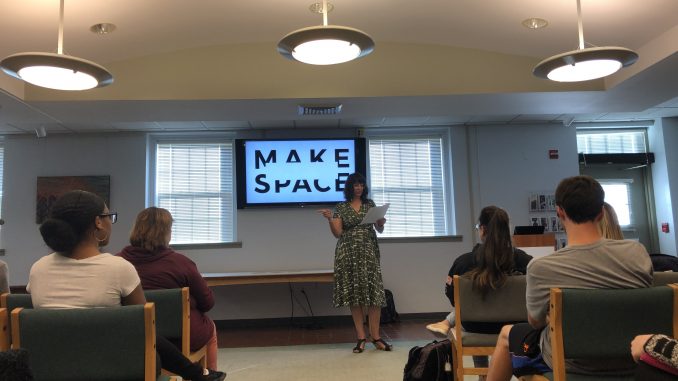
A 4.0 on a GPA scale isn’t the only metric that’s being evaluated in terms of academia, as a presentation called “Education 4.0: Teachers, Teaching & the Future” was introduced, delving into the ever-advancing world of technology with a focus on its presence in K12 classrooms.
Sponsored by the School of Education, Faculty Development Center and the Honors Program, several concerns were analyzed on Wednesday, Sept. 25 during this event held by Kiersten Greene, associate professor of literacy education in the teaching and learning department.
The title for this conversation was inspired by the current era of the internet, coined Web 4.0, as education is “traveling down a similar path” with improvements in smart technology and automation in correlation with our evolving digital world, according to Greene.
One goal of the presentation was to inform future and current educators, alongside other attendees, about society’s developing relationship with technology both inside and outside of the classroom.
At the beginning of the event, yellow and orange post-it notes were passed out around the room, inviting attendees to engage with the material and jot down their thoughts on two main concerns: one being what should be the purpose of technology in the classroom? and the second being what should be the purpose of technology in the world? In asking this, Greene urged attendees to reflect on why society is accordingly more concerned with how to use technology rather than why it is being used to begin with.
These questions derived from Greene’s encouragement of attendees to “make space” for meaningful conversations surrounding technology’s position in society, not to simply let it be. Adding onto this, Greene stressed that there is not much discussion about the short and long term effects of utilizing technology in the classroom and beyond—and that there should be more discussion, especially because we do not yet fully know the specific environmental, physical and mental health effects it may possess.
“We’re building this ship while sailing it, which feels like we’re constantly reinventing the wheel,” Greene said. “We need to make sure that teacher educators—the people who are teaching the future teachers—are part of the conversation, where the decisions are getting made about our future with technology in the classroom.”
Artificial intelligence (AI) was also a pointer that steered the presentation, as attendees were asked to define their understanding of this term through “Mentimeter,” an interactive presentation software. Responses to this category included: Siri and Alexa, the virtual assistants for Apple and Amazon respectively, robots, “cool technology” and “computers that think as people.” Greene expressed during this activity that no information was being collected from attendees’ personal devices, but that it could be from hers as she signed in with an account.
During the Q&A session held after Greene’s presentation, fourth-year early childhood education (English) major Carlee Parker expressed concern over her own experience with her Amazon Alexa device in one room that unexpectedly responded to their Google Home device in another.
“We unplugged it and a couple months later we plugged it back in, because it was convenient to ask it questions,” Parker said. “It’s kind of scary to think about what exactly we are willing to give up in order to have that convenience over technology.”
Another student, second-year early childhood education (Spanish) major Rosemary De La Cruz, expressed her concern over the advancement of technology and its accessibility to others.
“The educational structure in general is pretty classist, like it’s not meant for lower income households and families and students… certain [technologies] are not accessible to all, which usually is kids of color,” De La Cruz said. “I think the presentation started a conversation that hasn’t really started but needs to be more spoken of. I’ve always seen technology as controversial for myself and for education, but this has definitely made me realize the severity of technology.”
In the fall of 2016, Greene shadowed one first grade and two fifth grade teachers a couple times each month during the school year, in addition to serving as a source for professional support when desired by the educators. Greene did this to better understand the classroom environment in the midst of the 2014 Smart Schools Bond Act’s requirement in K12 school districts. This is a $2 billion act that has strived to increase the amount of “educational technology and infrastructure to improve learning and opportunity for students throughout the State,” according to the New York State Education Department.
Greene does not define herself to be either anti-tech or pro-tech, but hopes that conversations like this one will pave the way for further thought on technology’s existence in humanity and in children’s classrooms.
“[Technology] should be an opportunity for people to slow down, enjoy life more, take care of one another and disseminate information. It should be something that connects us,” Greene said. “A lot of the rhetoric around technology, especially in education, says that it’s a universal equalizer–but in the classroom, it’s not always, unfortunately. There is this expectation that technology will make our lives more convenient and better…but it just seems like we have more and more and more to do.”

